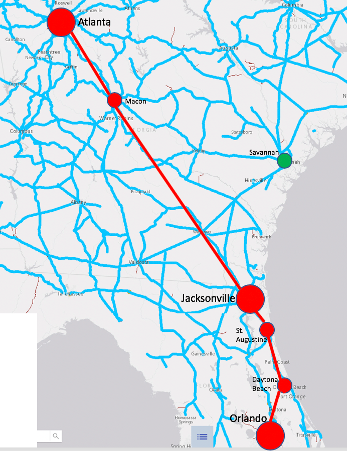A guest post by David Phillips
Possibilities in the Southeast
The FRA Southeast Regional Planning process has identified the Atlanta-Macon-Jacksonville-Orlando Corridor as among those with the highest ridership potential in the country. The corridor is approximately 480 miles long and fits the classic “too long to drive/too short to fly” situation where high performance rail has proven to be most successful. End-to-end driving time is over 8 hours and airfares on short-haul flights are high. There are several cities along the route so the route would serve passengers traveling between many city pairs.
The FRA Study has indicated that this route would have enough potential ridership to be appropriate for treatment as a “Core Express” high speed rail corridor, with dedicated, electrified passenger-only track with no at-grade roadway crossings, enabling operation at up to 220 mph, with frequent service (at least, hourly) during most of the day. End-to-end travel time would be expected to be less than 4 hours.
Part of a “Phased Network” approach
In the long run the HSRA envisions this Core Express Corridor being linked initially with the proposed Chicago-Indianapolis Core Express Corridor, with additional segments constructed sequentially in a “Phased Network” approach:
- Atlanta-Chattanooga – has a completed FRA Tier 1 FEIS/ROD for a Core Express route
- Chattanooga-Nashville
- Indianapolis-Louisville
- Louisville-Nashville
Some of these segments might remain with track shared with freight but, possibly, electrified, for some time (“Regional” service in the FRA hierarchy) but thru Chicago-Florida service could be operated, possibly with several trains per day, serving passengers traveling between the multiple city pairs in the corridor. These would likely primarily be relatively short and medium distance travelers, attracted by competitive travel times and reasonable fares, but there would be a significant number of travelers Chicago/Indianapolis and Florida points. Over time, succeeding segments could be upgraded to Core express standards.
Previous Studies in the Corridor
Georgia DOT issued a draft final report on a comprehensive feasibility study of an Atlanta-Macon-Savannah-Jacksonville route in 2012 (available from the GDOT Rail website at http://www.dot.ga.gov/IS/Rail). Thus, only the Atlanta-Macon segment is the same as analyzed in the FRA Regional Plan process. The FRA Study proposes a separate route between Macon and Savannah, to permit a more direct, faster routing to Jacksonville. By extending its analysis to Orlando the FRA Study was able to include many additional trips. The Macon-Savannah segment is identified in the FRA Study as a “Regional” route, thus operating with a top speed of 80-125 mph, possibly with some track shared with freight, not necessarily electrically-powered throughout, and leaving some at-grade roadway crossings, with safety upgrades to permit higher speeds (up to 110 mph).
It is believed that there has been no analysis of what would be involved in providing direct, high speed rail service in the segment between Macon and Jacksonvile, about 210 miles long. There is no interstate, or state, highway corridor to follow for most of this distance and there is a gap of about 60 miles where there is no railroad (and never has been).
There are three potential alternative routings between Jacksonville and Orlando (presumably, terminating a the new MCO Airport station to provide connectivity with the planned Brightline service to Miami, Disney, and Tampa, as well as air service). They vary significantly:
- Inland – Amtrak currently operates on an inland route. The portion between Orlando and Deland was purchased from CSX by Florida DOT and has been double-tracked as far north as DeBary in Volusia County to enable operation of Sunrail commuter rail service. As part of the purchase CSX re-routed thru freight off the line and more recently had announced its intention to abandon a major portion of the line between the FDOT territory and Jacksonville. There has been discussion of transferring ownership (and maintenance responsibility) of a 52 mile long portion of this route to Amtrak; it is unknown whether this has occurred. This routing could serve existing Amtrak stops: Palatka, DeLand, Winter Park, and downtown Orlando.
- Via Cocoa – Brightline (aka Virgin Trains America), which is currently constructing a route from Orlando to Miami, has stated that, in the future they anticipate extending service from Orlando Airport (MCO) to Jacksonville, apparently using the new track they are now constructing east to Cocoa (40 miles) and then operate on the historic Florida East Coast Railroad (FEC) route to Jacksonville (as their current project does south of Cocoa). This routing could serve St. Augustine, Daytona Beach, and Cocoa.
- Via I-4 corridor – This section, about 40 miles long, would involve constructing a new railroad in the I-95 and I-4 corridors. This routing was part of the early planning for high speed rail in Florida; it is unknown how much analysis was performed as part of that project. More recently, a conceptual design study of the I-4 portion, as an extension of Sunrail commuter rail service to Daytona Beach Airport, was completed in 2015. Apparently, the connection to the FEC was not analyzed. This routing could serve St. Augustine, Daytona Beach, a stop in Volusia County, Winter Park, and downtown Orlando.
These alternatives vary significantly in the size of the markets they would serve, and the amount of track sharing with freight and/or commuter rail trains that would be involved. All of them now have many at-grade roadway crossings. New, dedicated, grade-separated high speed rail track could be constructed over part/all of these routings. Careful analysis, and negotiation with the owners, would be required to identify the optimal arrangement.
Next Steps
The next logical step in the standard FRA Project Development Process would be to conduct a feasibility study for the route, as now proposed. Any study needs a Project Sponsor which is, most often, a state DOT. As an interstate route this is a case where having an individual state, which could appear to have a bias in the analysis, lead the project may not be appropriate. The newly-established Southeast Corridor Rail Commission may be the appropriate agency to serve as project sponsor for the overall corridor feasibility. Georgia may want to analyze a separate Atlanta-Macon-Savannah service as parallel/integrated effort. The elements of a feasibility study for this overall, end-to end, corridor would likely be:
- Develop/document conceptual routings for all segments at high level, but possibly for one, or more, corridors about 1000 feet wide, suitable for analysis in a Tier 1 EIS. The complex segment north of the Atlanta airport should, logically, be left to the more advanced Tier 2 analysis that is expected as a followup to both the Atlanta-Chattanooga and Atlanta-Charlotte Tier 1 EIS RODs.
- Refine ridership (this might re-analyze the impacts of a routing via Savannah).
- Develop a sketch level service plan, allowing the number of trainsets and crews, and sizing of train storage and servicing facilities to be estimated. This should discuss options.
- Develop a high level cost analysis.

Get Involved
Tell the United States Congress: It’s time to reconnect the country with high-speed and regional rail!

